It was a peaceful Saturday morning. The sun was out. The skies were blue. A few birds were singing. Overall it was one of those beautiful late May days here in Chicagoland. I was completely unaware that coming my way was attack which no mere mortal could stand in the way of, the slashdot effect was heading my way.
I began by thinking that my broadband connection was just a little slow. I was browsing CNN and Slashdot some and it seemed a little slow. I attributed this, at first, to some over aggresive filters that I had running. You see, I run a healthy dose of portsentry on my computer. This means that quite frequently sites get blocked if they try to open connections to my computer. In the past this has blocked CNN and OSDN’s ad servers, IIT’s webmail, and a host of other sites that I find generally useful.
Anyway, stuff was slow, so I reloaded slashdot for about the fifth time that morning, and that’s when I saw the horror. My weblog had made front page news on slashdot. The fury was about to begin…
The Beginning
The original article was posted to my web page at 4:30pm CDT on May 23rd, 2003. Shortly afterwards I posted a comment on this thread at deadly.org which had inspired my work in the first place. The time of that comment was about 10 minutes later (deadly is in eastern time). It’s unfortunate that deadly didn’t automatically linkify it like it was supposed to because I can’t track how many people came to visit it after that.
CowboyNeal posted the article on the slashdot homepage at 9:10AM CDT on May 24th, 2003. Previous to this point in time there was not a single person who followed a referrer to my page. Meaning that slashdot was the first link that was pointed to my site. The first reference to slashdot that appears in my log was from cache-1.atw.pa.webcache.rcn.net, it’s hard to tell if this is the person who submitted the article, or a slashdot editor. My hunch is that the slashdot editor used the address 24.247.221.123.kzo.mi.chartermi.net as I’m pretty sure they all still live in the Holland/Grand Rapids/Kalamazoo area. These first hits started around 8:53AM CDT.
Previous to this point I had received 39 visits to the page with no referrer tag marked. This means that deadly has higher traffic than I thought as there were 39 people willing to paste the URL I posted into their location bars. Another interesting thing is the number of people who used the near future feature of slashdot was fairly low. Only 14 hits registered a referrer from slashdot before 9:10AM CDT on May 23rd.
The Initial Onslaught
At 9:10AM we saw the initial barrage begin. I figure that at this point it was the actual posting of the article on slashdot because the hits started to come fast and furiously. What we see below is a plot of the hits versus time for the first few hours. The red steps are the hits that I received for that minute and the green line is the smoothed version of those results using gnuplot’s bezier option. It’s not a true trend line, but it’s good enough for my work here. This graph includes only requests for the actual document, and not the associate style sheets.
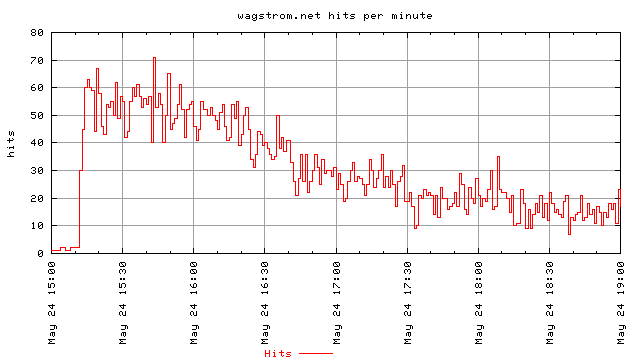
We can see that the server peaked around 1 request per second for the page. With associated requests for browsers that automatically request favicon.ico and the stylesheet this would be multiplied by a factor of two to three. It also should be noted that ideally only one of those requests would go out and try to fetch the hostname of the requesting host, although I can’t be sure of that because I didn’t collect that information.
Another issue of concern was the total bandwidth that was being consumed. While I don’t have a 100% accurate way of measuring this, I can get a good estimate based off the number amount of data the apache says it sent each minute. This shows the bandwidth consumption for the initial slashdot effect and includes the css sheet, but it does not include the HTTP headers that were sent and the overhead if the data was chunked.
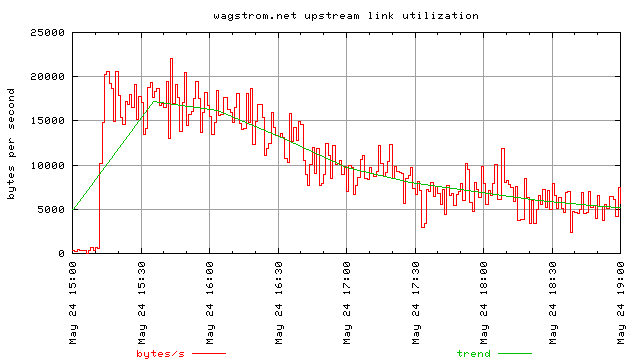
Surprisingly enough, it seems like the actual server processes held up pretty well. The computer that runs these servers is nothing spectacular, that’s for sure. It’s a little K6-200 with 4 gigs of hard disk and 96 megs of ram; network connectivity is done via 2 ISA ethernet cards. During the slashdotting I had no problem sshing into the computer on the second interface and looking around.
When I logged in I saw that the total system load was around 0.7. This was at the peak of the slashdotting. I also looked at the number of running httpd servers, it was around 30 or so. This is far less than the 150 max servers that I had set in the configuration file. I did notice things were a little slow and eventually traced this back to MySQL dieing a brutal death. Apparently it only recently became stable on current. This is the first time that I had problems with MySQL under OpenBSD, so I would have never known it was unstable. This is also why there are no comments from the peak of the slashdotting. People just couldn’t connect to the mysql server.
The After Effects
After I realized that my broadband connection wasn’t going to be of any use for the near future and observed that it was one of those very rare days in Chicago when the weather was actually nice, I decided to leave the system be and go outside. I returned later that night and found that my broadband connection was very usuable again, and almost to the point where it seemed like nothing happened.
The following graphs provide more information on how the slashdot effect slows down. It seems like it has an exponential decay in the number of requests.
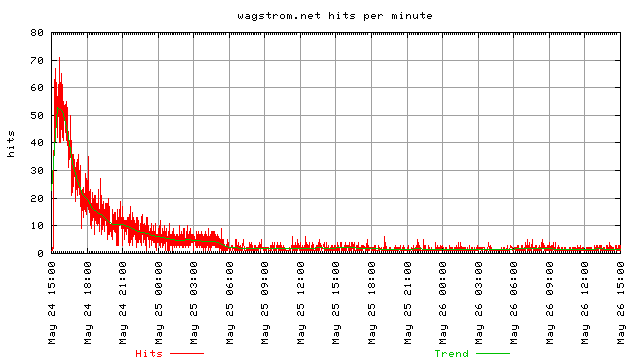
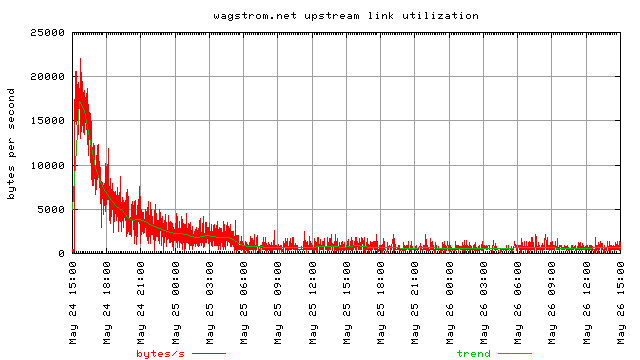
It’s pretty clear that by 6 hours after the initial posting to slashdot, my broadband connection was easily usuable again. By 12 hours after the initial slashdotting the stream had slowed to a point where it would be very hard to even tell that a slashdotting had occurred.
Collateral Damage
As mentioned in the article, this was all inspired by some images on Daniel Hartmeier’s site. I also linked to those images. After the slashdotting I requested and received the logs from his site for the related images and found some interesting information. First of all, there were 6275 total requests made to his site because of this article. Of which 5528 came from my copy of the article, and 747 came from the mirror that slashdot posted at lmo.warcry.com.
These two graphs illustrate the bandwidth used only by references from the two links on slashdot. I didn’t try to track visits and see how much total bandwidth was consumed if someone clicked to go to the index page and then browsed around for a long time. These are only cases where the referrer is one of the two sites on slashdot. The first one is for the first four hours of the slashdotting, the second one is for the 48 hours after the slashdotting. Once again, these represent the bandwidth only as his web server, thttpd, reported it.


This should be a concern for anyone that links to things on the web, especially if you know that page might be slashdotted. From reading Daniel’s page, he states that he has a 128Kbps dsl line. This means that his upstream is capped around 100Kbps after you factor in PPOE overhead. Thus, at the initial onset, when it was averaging to over 5k/s, with spikes up to 10k/s, the links alone were consuming a substantial portion of his bandwidth.
Moving along, we see that the requests on the linked site follows almost the exact same pattern as the request to the slashdotted site. There is a nice exponential decrease, however it isn’t quite as obvious because of the lower number of site visits.
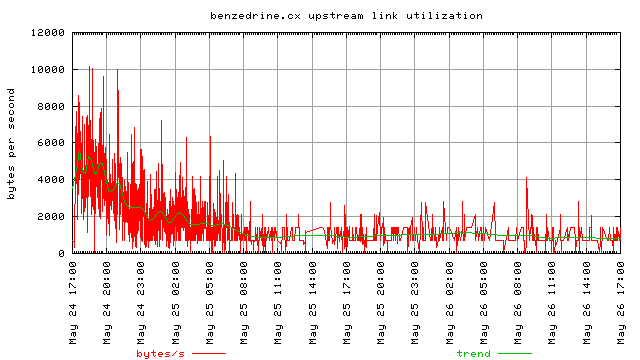
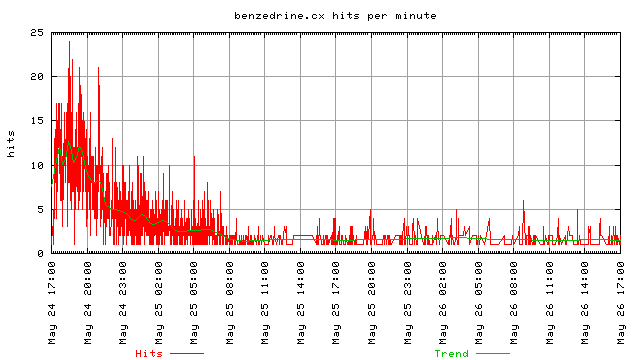
For the sample period in question, there were 11624 unique hosts that accessed the original document and 1858 unique hosts that accessed the mirrored document. Of those hosts there were 3290 hosts that accessed clicked through the links to see the pictures that provided my motivation. This means that there was 23.7% overall clickthrough rate on the links (28.7% from the mirror at warcry and 23.4% from the original document). I’d like to see web advertisers do that!
Now we’re on to the stuff that just doesn’t make any sense. Of the 3290 hosts that clicked through to benzedrine.cx, 239 of them clicked through from both the original document and the mirror. One has to wonder what these people were thinking. There were 637 hosts that visted both the original site and the mirror site. Meaning that in reality the mirror site only received about 1200 hits. By the time that the mirror was posted, the brunt had slowed down and it really didn’t matter anymore.
Preventative Measures
This whole document would be fairly useless unless I had actually applied some changest to help avoid a slashdotting in the future. Whill, you can’t really avoid it, unless you never post anything useful. So a better title might be dealing with slashdottings. I’ve listed a few pretty simple steps here that can help out in that respect.
The first is to turn off hostname lookups in your http log files. I had mine enabled because I happen to like looking at the log files and easily seeing where people came from, however, it means that most connections require an addition connection to the name server. Even though the nameserver was running locally, for an uncached address, this meant significant overhead. If you’re running apache look in your configuration file and make sure the following line exists:
#
# HostnameLookups: Log the names of clients or just their IP addresses
# e.g., www.apache.org (on) or 204.62.129.132 (off).
# The default is off because it'd be overall better for the net if people
# had to knowingly turn this feature on, since enabling it means that
# each client request will result in AT LEAST one lookup request to the
# nameserver.
#
HostnameLookups Off
Another interesting point is that I was bandwidth limited in this slashdotting. As noted before, my server load never crept above 0.7 (and once I fixed MySQL, it stayed around 0.4). The solution is to install mod_gzip (there would be a link to the webpage here, but the webpage appears to have gone missing). Almost every modern web browser supports using gzip compression to on the fly compress web pages. Being as the slashdot effect linked to my weblog, which is nothing but html and css, it’s not a problem to compress it. Mod_gzip takes advantage of this. You can find it in ports/www/mod_gzip.
Finally, I’m working on some additional tools. I’m writing my own mod_slashdotting module. I’m not sure if I’ll ever release it or not, but I bought the apache module book a few years ago and have yet to create anything productive from it. The basic premise is this. If the server detects more then n hits in m minutes, it will use will either shut down or use some dynamic pf rules to forward all traffic to a more powerful server. Not quite sure how all the mechanics of it are going to work yet.
Also, I’m doing some work stuff with altq in OpenBSD 3.3. This lets me limit my upstream bandwidth used by HTTP servers to an arbitrary amount. Thus, if I get slashdotted again, while slashdot can complain about not being able to reach my web page, at least I’ll still be able to access the rest of the network because I’ll have a slice of bandwidth available for me.
Comments On My Site
After seeing some of the comments on my site, it’s clear why slashdot has a moderation system. There were a lot of comments along that seemed to be made by 12 year olds (or people about the same level) that just were happy that they could make my website curse. That’s pretty clever considering there already are curses on my website in various rants. Anyway, it shows that for a decent traffic site, human moderation is helpful.
This is very clear in reading the quality of the comments. Although things more easily swayed off topic on slashdot, the comments seemed longer and more robust. Most comments on my website were short and to the point. Perhaps this has something to do with karma-whoring nature of many slashdotters.
Conclusion
The first thing that can be seen is that if your site gets slashdotted, don’t worry, it’s only temporary. Take the rest of the day off and go outside and do something else. It will be better in a few hours anyway. This is largely because slashdot traffic roughly follows an exponential decay model.
Another observation is that a well written article can get click through rates that web advertisers only dream of. A devious author could hide some links to pay-for-click sites in their HTML and make a tidy profit. I also wonder what the actual click through rate would have been for a site like Amazon where you can get a kickback if people buy the books that you reference.
One of the most interesting observations is how little a mirror site really helps in the case of a slashdotting. Either very few people choose to visit it, or by the time that it gets posted most people have already seen it. An interesting note is that the clickthrough on the mirror site was higher than the original. Perhaps future studies of the slashdot effect could help determine if this is a consistent thing, or just for this one article.
There were two rather disturbing results from this study. One is the power of slashdot to cause collateral damage. The documents I provided were very small static documents, while the documents that I linked to on benzedrine.cx were quite larger. This caused a significant amount of collateral damage to his site, based on my site being slashdotted. Secondly, the large amount of people who not only visited both the mirror and the original site, but the people who clicked through from both, seems quite high. I have to wonder why these people do such actions. Do they think that the article will be different at the different hosts?
Overall, I can say that the slashdot effect is no big deal. It saturated my broadband line for a short period, and I was a little worried that if it kept up Sprint might cancel my connection, but it slowed down quite quickly and in retrospect the bandwidth consumed is less than that of your average p2p user.
Acknowledgements
A substantial amount of this analysis would not have been possible without Daniel Hartmeier of benzedrine.cx and Lewt from lmo.warcry.com providing their httpd logs to me. Thank you very much for your help.